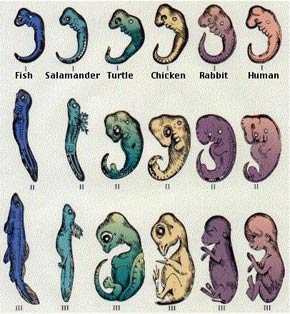Tool Module: The Connection between Ontogeny
and Phylogeny
The evolution of the human brain over millions of years and its development over the course of one lifetime are inextricably linked. In fact, the best way to get an overview of the stages through which our brain passed in the course of evolution is to look at those through which it passes as an individual develops.
| The phrase “ontogeny
recapitulates phylogeny” was coined by Ernst Haeckel in 1866 and for
many decades was accepted as natural law. Haeckel meant it in the strict sense:
that an organism, in the course of its development, goes through all the stages
of those forms of life from which it has evolved. That said, species
that share the same branch of the evolutionary tree clearly also go through the
same early stages of individual development, though they diverge subsequently.
One good example here is the basic skeletal structure of all vertebrates, which
is one of the anatomical structures that is laid down earliest in the process
of embryogenesis. In fact, the most precise way to describe this whole phenomenon might be to say that related organisms start with a common general embryonic form and then eventually diverge into distinct adult morphologies as they complete their development. |  |
To understand the link between phylogeny and ontogeny (in other words, between the evolution of a species and the development of an individual), one must understand that a species can evolve from a series of small mutations in the development program encoded in its individuals’ genes. The earlier that these mutations occur in an embryo’s development, the more likely they are to be lethal, because of the fundamental changes that they will involve. That is why we tend to see more mutations in the later stages of development, and why various species show similarities in their early embryonic stages. But sometimes a mutation in the program at an early stage of development will still leave the embryo viable, resulting in a differentiation of these early stages that erases any strict correspondence with the phylogeny of this species.That is why a strict interpretation of Haeckel’s law of recapitulation does not withstand close empirical scrutiny.
